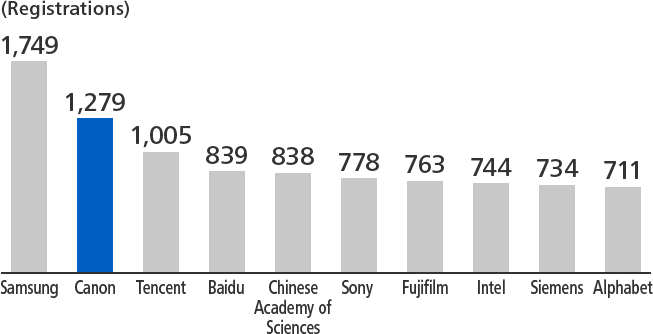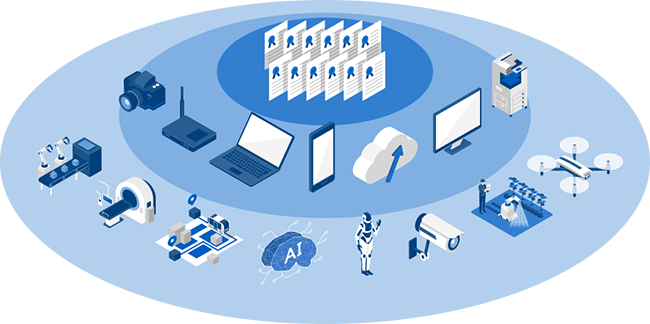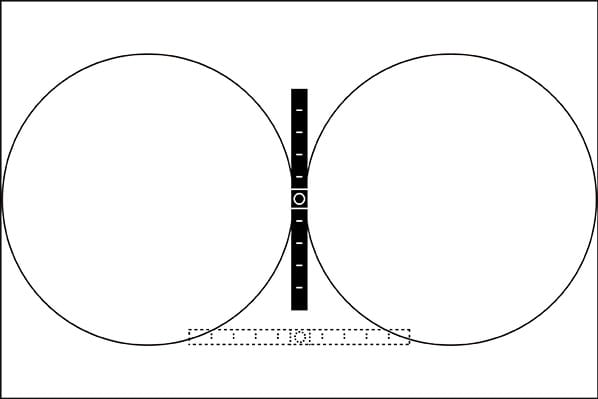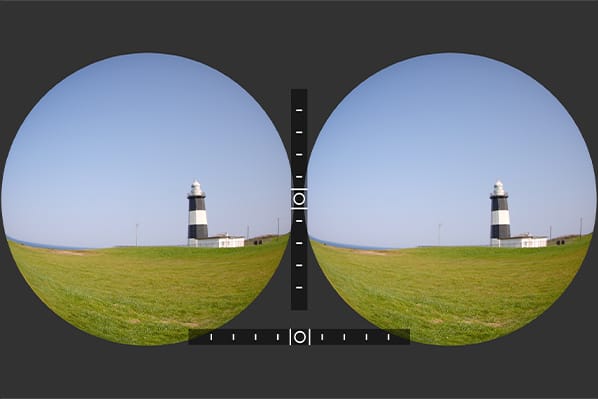Future
Strategies for Canon Intellectual Property Activities
- To continue to win -
In Canon's IP activities, in order to continue to win the battles in front of us, We have been practicing offensive and defensive IP operations from a long-term perspective, anticipating technologies and businesses to come.
To implement these, our basic strategy is to carry out a so called open/closed strategy that inter-relatedly combines the following three elements to continue to win.
- 01.Patents related to core
competence
technologies - 02.Patents related to
general-purpose
technologies - 03.Inventions that others
cannot
easily make
- 01. ▶Patents that protect our business in competitive domains, will not be licensed, but will be used to secure our competitive advantage.
- 02. ▶Patents such as communications and GUIs, in the cooperative domain, will conclude a cross-license agreement, to secure freedom in our R&D and business.
- 03. ▶Inventions that others cannot easily make are kept secret and protected as know-how, so that competitors are not able to emulate us and our competitive advantage is secured.

Promotion of intellectual property activities
Starting with the NP system of electrophotography in the 1960s, Canon's defensive intellectual properties, such as bubble jet, interchangeable lenses, consumables, and production engineering technology, have been the bases of our current businesses for many years, while our offensive intellectual properties have greatly assisted our response to the computerization and digitization of cameras and printers. These have contributed to the development and expansion of our businesses.
Although these basic concepts of IP activities have been handed down unchanged, our IP strategies and tactics have changed with the times. For example, competitors in the camera market are rapidly changing, and IT companies that do not compete with Canon in business but do compete in patents have emerged.
Along with these developments, industries that use common IT technologies, such as automobiles and housing, have also expanded. This results in a wide expansion of the range of parties with whom we have to negotiate on intellectual property issues.
We need to innovate and evolve our litigation and negotiation strategies to keep up with the times, and to prepare various tactics to battle flexibly according to the opponent. To this end, Canon will carry out intellectual property activities to keep renewing our patent portfolio as a weapon, in line with our business portfolio and the changing times.
Canon is now trying to jump-start four new businesses: commercial printing, network cameras, medical devices and industrial equipment. We are also focusing on the creation of future businesses such as the Free Viewpoint Video System, next-generation imaging such as XR, next-generation healthcare, smart mobility and so on. To ensure the sustainable development and growth of these new businesses, the Intellectual Property Division not only applies for patents and obtains rights for the core competence technologies, but also applies for patents and obtains rights for technologies in various fields with an eye to the future to maintain a strong patent portfolio.
As a result of mergers and acquisitions, many patents that will become the core of new businesses have been created by group companies. We will enhance synergies with the intellectual property activities of Group companies in Japan and overseas, solidify the foundation of our intellectual property activities of the Canon Group, and strengthen the Group's portfolio.
The world has entered the era of the "new normal" and digital transformation (DX), and technologies essential for cyber-physical systems (CPS) incorporating AI and IoT are becoming more and more important. We must also work to solve social issues such as SDGs, taking a long-term perspective. Regardless of whether they are new or existing, Canon's products and services need to be organically linked to CPS and social issues. Accordingly, we will step up our efforts to create and utilize standard-essential patents such as those for image data compression, wireless communication, and wireless power supply in IT-related fields, as well as implementation patents used in products based on standardized technologies.
We will also work hard on intellectual property for sensors, actuators, displays, and user interfaces (UIs), which are the entry and exit points for cyber-physical space, as well as the systems that use them. We will take a long-term perspective and strengthen our initiatives more than ever for environmentally friendly technologies such as energy conservation, recycled materials and manufacturing methods that reduce waste.
In collaborative domains and domains related to social issues, we will not only create patents, but also use intellectual property to create new value, making use of our designs, trademarks and brand power and forming alliances with suppliers and users.
As Canon Group, we will make the best use of our intellectual property to secure competitive advantages and freedom for our businesses, and at the same time continue to contribute to creating a better future society with products and services that have high added value or create new value.
IP Activities in Phase VI of the Excellent
Global Corporation Plan
Our aim for Phase VI of the Excellent Global Corporation plan is to improve the competitiveness of all Canon Group operations across each of its four business areas of printing, imaging, medical and industrial through IP activities. At the same time, we are directing our efforts at supporting future business creation in areas such as next-generation imaging, which includes volumetric video and extended reality (XR, a term encompassing VR, AR and MR), next-generation healthcare, and smart mobility.
To help underpin the development and growth of these businesses, Canon's IP Division is focusing efforts on creating and commercializing IP assets relating to core competence technologies (such as optics, image processing and analysis) and technologies that will be essential for cyber/physical systems that incorporate AI and IoT.
Printing Print engines and solutions
Canon's Printing Group works to strengthen our patent portfolio of next-generation core technologies relating to printers, such as print engines, materials, and key components. The Group also aids the differentiation of the entire printing business surrounding printers by constructing a broad patent portfolio of technologies underlying the solutions we provide to a diverse base of customers, including home users and shared office users. In addition, it maintains strong IP collaboration platforms with Group companies that support the printing business.
Imaging From camera business to optics industry
The Imaging Group is pushing out video solutions to its camera product lines for video production and security applications by integrating network technologies, into core technologies, in addition to focusing on mirrorless cameras that take advantage of core technologies in optics and sensors. At the same time, it is expanding our patent portfolio relating to these technologies. The Group is also active in creating IP in areas that will fuel next-generation entertainment and public infrastructure. These areas include volumetric videos, XR, and other 3D-space image processing technologies as well as smart mobility tech typified by driving-assistance cameras.
Medical New value provision to medical practice frontline / Competitiveness enhancement and business domain expansion
A large part of the Medical Group's IP strategy is developing its technology portfolio which continually creates new value for the medical field, such as AI solutions that are revolutionizing the provision of precision medicine (personalized medicine) and photon-counting CT scanners. These IP activities help generate technological synergies within the Canon Group and facilitate collaborations with research institutions around the world. They also boost our competitiveness in the diagnostic imaging field and help expand the Group's business into such domains as healthcare IT and in vitro diagnostics.
Industrial Reforming the semiconductor industry
The Industrial Group implements both open and closed strategies using patents and knowhow in the fields of lithography systems, die bonders, OLED fabrication systems, and sputtering equipment. The Group is also focused on IoT for industrial equipment.
In the nanoimprint lithography (NIL) field, the Industrial Group is leveraging industrial-academia-government partnerships and collaborations with Canon Group companies to build a formidable patent portfolio that ranges from material technologies, elemental technologies, and mounting technologies through to semiconductor processes.

Constructing patent portfolios
Canon identifies emerging social and economic trends from various changes and developments in the business landscape and invests considerable resources into acquiring IP rights connected to our business core competencies as well as IP rights that anticipate future business trends. In parallel with this, we regularly review the value of our patents and update the rights we hold to maintain a powerful patent portfolio.
-
Example 1: AI-based video/image processing
Regarding video and image processing which are positioned as Canon's core technologies, we are discovering and developing new technologies based on our existing technology assets.
For example, as of March 2023, we ranked second globally for numbers of patents owned in AI-based video/image processing (on patent - families basis).
These kinds of elemental technologies are leveraged to create new technologies for image recognition in the Imaging Group or diagnostic imaging in the Medical Group, thereby contributing to the realization of better products and services. Global ranking for imaging-related machine learning / AI patent registrations
Compiled by Canon using PatentSight®by LexisNexis
(Based on March 2, 2023 data from ip-search as provided by the Swiss Federal Institute of Intellectual Property using International Patent Classification tech fields H04N and G06T) -
Example 2: 3D spatial video processing
Canon is investing in image processing for 3D spaces in order to evolve the role of imaging from shooting and viewing to experiencing and applying images as well as to create new business domains. To support this, we are enhancing the construction of IP portfolios for both core competency technologies and general-purpose technologies. One area is our IP portfolio relating to volumetric videos. For example, we hold patents on the underlying technologies for high quality volumetric videos and technologies that realize the high-speed, real-time processing of enormous amounts of video data for applications in arenas and stadiums. We also hold patents that contribute to the production and distribution of volumetric videos. These technologies are being applied in areas such as broadcasts of professional basketball (US) or baseball (Japan), TV commercials, and music videos. Growth of volumetric video technology patent registrations (global registrations)

-
Example 3: Standardization Activities
Canon continues to contribute to the development of global technologies via active participation in standard setting organizations, utilizing not only domestic expertise but also the expertise of overseas researchers in these fields. The many inventions relating to our technical contributions continue to expand our standard essential patent portfolio. Canon's patents include technology fields of mobile communication (5G, Beyond 5G, 6G, etc.), wireless LAN (Wi-Fi, etc.), video encoding (HEVC, VVC, etc.), and wireless power transfer (Qi, etc.). The more our patents relating to next-generation technical standards are adopted in various products and services of many companies, the more the value of our patents increases, and consequently our IP competitiveness continues to grow.

Trademarks and Design rights practiceNEW
Canon handles the tasks related to trademarks and design rights in a single department. This trademark and design department not only deals with the filling of trademarks and design rights but also monitoring and watching the latest technologies such as NFTs, metaverse spaces, AI creations, as well as trends in related laws such as copyright and unfair competition prevention. The department works closely with other intellectual property departments in various locations around the world to maximize Canon brand value.
Global governance of trademark
The Canon logo, conceived in 1935 as a "globally recognized trademark," The Canon logo has been registered as a trademark in over 190 countries and regions. Canon promoted the protection of brand by establishing a global trademark management policy in the early 2000s Now many other Japanese companies are exploring the establishment of global intellectual property governance that contributes to company management, prompted by revisions to corporate governance codes in recent years.
In China, Canon recognized early on the importance for brand penetration of using Chinese characters and since 2006 we have been using the Chinese character 佳能 (read as “jiānéng”) in addition to the Canon logo in roman characters as a company brand representation.
The pleasant sound and meaning of 佳能 in Chinese have led to a number of similar trademark applications by third parties. However, Canon protects its brand and consumers by filing around 50 formal objections in China each year to such trademark applications. Our successes in protecting our trademarks in Asia have attracted positive recognition and earned us the title of Technology and Consumer Team of the Year in the 2023 awards granted by World Trademark Review, a multimedia publication by Law Business Research.
Canon Design Identity
In Canon Design Center, we have set out a concept known as “Canon Design Identity” aimed at improving brand value by coordinating designs across different product genres and in turn generating high-quality designs. In order to ensure that our products embody this concept, Canon Design Center articulates Canon’s distinctive personality and conducts weekly reviews to ascertain whether there is scope to increase design quality. The trademark and design department shares the Design Center’s awareness of the Canon Design Identity and how it shapes the Canon brand and members of the department follow the same approach as they apply for and acquire design rights.
Promoting the IP MIX Strategy
We are actively promoting an IP MIX strategy, which combines multiple forms of intellectual property, such as patents, design rights, trademarks, know-how, and copyright, to protect our products and services. Therefore, our trademark and design patent specialists collaborate not only with the business units and designers but also with the R&D divisions and patent teams. Canon’s IP divisions adopt the approach of engaging in a wide range of activities rather than focusing excessively on one particular type of intellectual property.
As one example, we focus on graphical design rights as a means to protect the user experiences and user interface designs supported by our unique technology. Graphical design rights are a newly introduced category of design patent protection in Japan. Unlike patents, design rights allow for the protection of the design itself. As we apply for and acquire such rights, we are conscious of the need to protect one product in various ways—which naturally includes securing patents to protect the user experiences that are grounded in technology, but also applying for graphical design rights of the supporting graphic design and of the very design of the graphic user interface that seeks to ensure accessibility for users.
We envision what kinds of design rights will be effective tools for utilizing in business five or ten years from now and seek to apply an open-minded approach to generating ideas.
Example of graphic design rights: Level measuring graphic (Design right registration no. 1731392)▼
-

Drawing -

Example reference graphic image view of use
